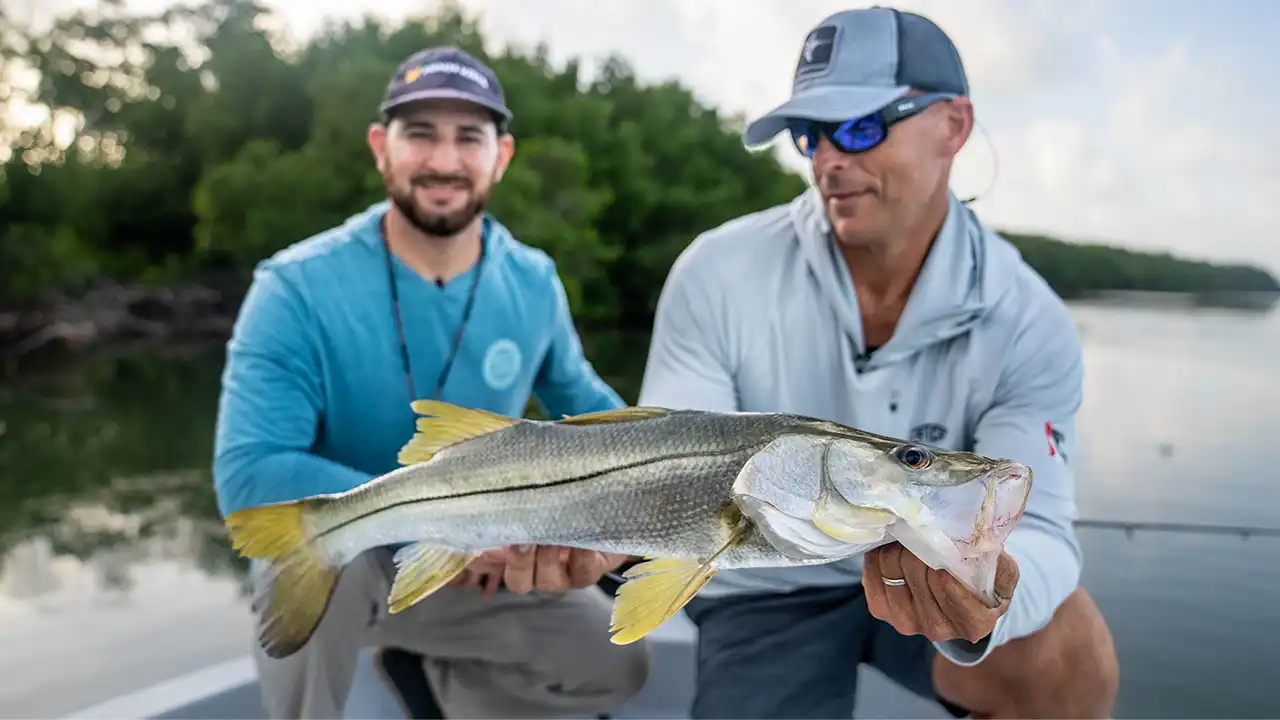Snook fishing with shrimp under a bobber is an effective technique, especially when targeting fish around cover and moving tides. Florida-based saltwater pros Nestor Alvisa and Ed Zyak break down a simple but effective popping cork rig, designed to attract snook and keep the bait in the strike zone longer. While they target inshore snook from Alvisa’s inshore boat, the technique works equally well from shore.
TACKLE AND ROD SETUP
- Saltwater Jigheads at Bass Pro Shops
- POPPING CORK – Four Horsemen Tackle Oval Popper Float: Buy at Bass Pro Shops
- ROD – Daiwa TD SOL Inshore Spinning Rod, 8′ Heavy: Buy at Tackle Direct
- REEL – Daiwa BG MQ (BGMQ4000D-XH): Check out at Daiwa | Buy at Bass Pro Shops
- LINE (braided mainline) – Daiwa J-BRAID x8 GRAND, 15- to 20-pound: Check out at Daiwa
- LINE (fluoro leader) – Daiwa J-Fluoro Leader, 30-pound: Check out at Daiwa | Buy at Tackle Warehouse
- SUN SHIRT (Nestor) – AFTCO Ocean Bound LS Sun Protection Hoodie: Buy at AFTCO
- SUN SHIRT (Ed) – AFTCO Jason Christie Hooded LS Performance Shirt: Buy at AFTCO
THE BEST SNOOK FISHING RIG: POPPING CORK SETUP
This setup consists of a popping cork—a wire-through float with beads on top, a jighead at the bottom, and a live shrimp for bait. The key to this rig is the sound: popping the cork creates a clacking noise, mimicking natural baitfish sounds and drawing snook in from a distance.
Snook are ambush predators that position themselves in areas with current flow and easy access to bait. By fishing a popping cork near channels, mangroves, and tidal cuts, you increase the chances of getting bites on both incoming and outgoing tides.
WHERE TO FISH FOR SNOOK USING A FLOAT AND SHRIMP
Identifying productive areas is crucial. Satellite imagery makes it easier to spot key locations like:
- Shorelines with structure – Snook use points and submerged cover to ambush bait.
- Deepwater channels – These act as highways for fish movement with the tides.
- Tidal eddies – These slow-moving areas near current seams hold feeding fish.
Using trolling motors with precise positioning capabilities, like Spot-Lock, auto-deploy and depth-adjustment features, allows for easy boat control and a controlled approach. Slowing down and fishing methodically is key when using a float and shrimp setup. Shallow water anchors like the Minn Kota Raptor also have their place for easy anchoring in skinny water.
BOAT SETUP & MISC.
- TROLLING MOTOR – Minn Kota Riptide Instinct QUEST: Buy at Bass Pro Shops | Buy at Minn Kota
- SHALLOW WATER ANCHOR – Minn Kota Raptor Active Anchoring Shallow Water Anchor – 10′ – Black: Buy at Bass Pro Shops
- FISH FINDER – Humminbird APEX 16 MEGA SI+ Fishfinder/Chartplotter CHO: Buy at Bass Pro Shops | Buy at Humminbird
- TRANSDUCER (thru-hull) – SSTH 14 HW MSI+ T – SOLIX MEGA SI+, DI+, DS CHIRP w/ Temp Thru-Hull Transducer: Buy at Humminbird
- MAPPING – Humminbird CoastMaster V1: Buy at Bass Pro Shops | Buy at Humminbird
- BOAT – Pathfinder 2700 Open “Hybrid style bayboat: Check out at Pathfinder
MOTOR – Yamaha 5.6L V8 XTO Offshore: Check out at Yamaha
HOW TO HOOK SHRIMP FOR SNOOK FISHING
There are two effective ways to rig shrimp for snook fishing:
- Horn Hooking: Insert the hook just under the horn, keeping it away from vital organs. This allows the shrimp to swim naturally.
- Tail Hooking: Remove the tail flipper and hook through the back. This gives the shrimp a more erratic movement that triggers strikes.
Adding a short monofilament leader above the popping cork reduces line tangles, while adjusting the depth ensures the bait stays just above the bottom. This setup works best when fished methodically in areas where snook are staging.
WHY TIDE TIMING MATTERS FOR SNOOK FISHING
Understanding tide movement is one of the biggest factors in catching snook. Fish position themselves to conserve energy while waiting for food to be delivered by the current. Humminbird CoastMaster tide charts help anglers determine when to move into a spot and when to leave before the bite shuts down. Nestor stresses that most action occurs near shoreline cover or points where the current breaks and creates feeding lanes. Once snook move, repositioning can help reconnect with the fish.












